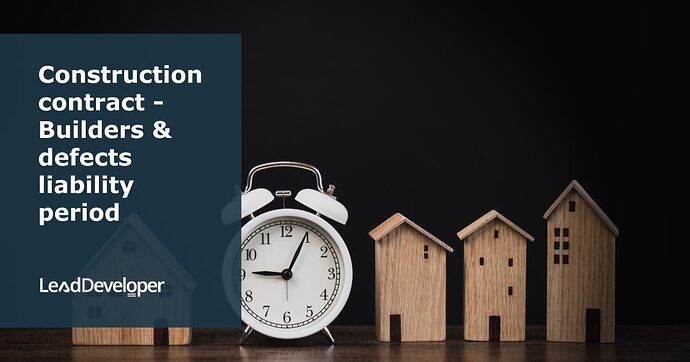Builders & Defects Liability Period
This article provides insights into the crucial aspects of construction contracts, focusing on the builder’s liability and defects liability periods. It highlights the roles of builders, structural engineers, and building surveyors in ensuring the integrity and safety of construction projects through detailed inspection stages.
Builder’s Liability Period
Also known as the builder’s warranty period, covering rectification of defective material, poor workmanship, and structural defects.
Structural Defects
Involves not only the builder but also the structural engineer and the building surveyor, especially in Victoria where every construction stage must be cleared by the surveyor.
Inspections
Critical stages require booking inspections, highlighted in the project schedule, ensuring that construction does not proceed without clearance.
Defects Liability Period
Typically six months for minor defects, such as roof leaks or improper waterproofing.
Insights based on numbers
The structural defect warranty lasts between seven to ten years, varying by state.The defects liability period for minor issues is generally six months, underscoring the immediate post-construction phase for addressing such concerns.
Frequently Asked Questions
What is the process of inspection bookings during construction?
Different stages of construction require specific inspections, which are meticulously planned and scheduled. The project schedule is color-coded, with pink highlighting the times when inspections need to be booked.
This systematic approach ensures that each construction phase is thoroughly inspected and approved before proceeding to the next, maintaining the project’s integrity and adherence to safety standards.
The use of automated programs for reminders and emails is also highlighted, demonstrating the importance of organization and timely communication in managing construction projects.
What is the Builder’s Liability Period?
The Builder’s Liability Period, also known as the builder’s warranty period, is a specified timeframe within which builders are responsible for rectifying any defects related to materials, workmanship, and structural integrity of a construction project. This period ensures that builders correct any issues that compromise the quality and safety of the construction, safeguarding the interests of homeowners and project stakeholders.
What are Structural Defects?
Structural defects refer to significant issues within a construction project that affect the structural integrity and safety of the building. These defects could be related to foundational problems, issues with the load-bearing structures, or any other fault that poses a risk to the building’s stability. Addressing structural defects involves not only the builder but also structural engineers and building surveyors, particularly in regions like Victoria where construction stages are closely monitored and require clearance from a surveyor.
What role do Inspections play in the Construction Process?
Inspections are crucial at various stages of the construction process to ensure that each phase meets the required safety and quality standards before proceeding to the next. These inspections are scheduled and highlighted in the project’s timeline, with a clear emphasis on the necessity for construction work to pause until clearance is obtained. This system of checks and balances aims to prevent the progression of construction with potential defects or safety issues unaddressed.
What is the Defects Liability Period?
The Defects Liability Period is a designated post-construction timeframe, typically lasting six months, during which builders are obligated to fix minor defects such as roof leaks or issues with waterproofing. This period focuses on addressing non-structural problems that may emerge shortly after the construction is completed, ensuring that the project meets the agreed-upon standards and quality.
How long does the warranty last for Structural Defects?
The warranty coverage for structural defects varies by state but generally lasts between seven to ten years. This extended period reflects the significance of structural integrity for the overall safety and longevity of a building. It ensures that any structural issues that emerge within this timeframe are rectified by the responsible parties, typically involving the builder, structural engineers, and building surveyors to guarantee the building’s stability and safety.
Why does the Defects Liability Period for minor issues last generally six months?
The six-month duration for the Defects Liability Period for minor issues is set to address and rectify any immediate concerns that arise post-construction, ensuring that they are dealt with promptly. This timeframe is generally considered adequate to identify and fix non-structural defects that could affect the building’s functionality or aesthetic appeal, thereby maintaining the quality and satisfaction of the stakeholders involved.
Test Your Knowledge
1. What is the primary purpose of the Builder’s Liability Period?
A. To increase the construction project’s cost
B. To ensure the builder completes the project on time
C. To cover the rectification of defective materials, poor workmanship, and structural defects
D. To market the construction project
2. Who are involved in addressing structural defects in a construction project?
A. Only the builder
B. Only the structural engineer
C. The builder, structural engineer, and building surveyor
D. The interior designer and architect
3. In Victoria, what is required before proceeding to the next construction stage?
A. Approval from the city council
B. Clearance from a building surveyor
C. A press release
D. Payment from the homeowner
4. What does the Defects Liability Period typically cover?
A. Only aesthetic defects like paint and finish
B. Structural defects only
C. Minor defects such as roof leaks or improper waterproofing
D. Defects that occur 10 years after construction
5. How long does the structural defect warranty last?
A. 3-5 years
B. 5-7 years
C. 7-10 years
D. 10-12 years
6. What is the typical duration for the Defects Liability Period for minor issues?
A. 3 months
B. 6 months
C. 12 months
D. 24 months
7. Which statement best describes the role of inspections during the construction process?
A. Inspections are optional and can be skipped if the project is behind schedule.
B. Only the final inspection is necessary to proceed with the construction.
C. Inspections at critical stages are required, ensuring construction does not proceed without clearance.
D. Inspections are conducted only if the homeowner requests them.
Answers:
- C. To cover the rectification of defective materials, poor workmanship, and structural defects
- C. The builder, structural engineer, and building surveyor
- B. Clearance from a building surveyor
- C. Minor defects such as roof leaks or improper waterproofing
- C. 7-10 years
- B. 6 months
- C. Inspections at critical stages are required, ensuring construction does not proceed without clearance.
Assignment
Understanding Builders & Defects Liability Period
Objective:
This assignment aims to deepen your understanding of the concepts related to builders’ liability, defects liability period, the role of inspections, and how structural defects are managed in the construction industry. You will apply what you’ve learned from the article to analyze real-world scenarios, conduct research, and engage in critical thinking about construction contracts and the associated responsibilities.
Part 1: Questions & Responses
Describe the Builder’s Liability Period.
-
What does it cover?
-
Why is it important for homeowners and builders?
-
Explain what is meant by ‘Structural Defects’.
-
Identify at least two examples of structural defects.
-
Discuss the roles of the builder, structural engineer, and building surveyor in addressing these defects.
-
Outline the process of inspections during the construction phase.
-
Why are these inspections critical?
-
What could be the consequences of proceeding without clearance?
-
Define the Defects Liability Period for minor defects.
-
Provide examples of minor defects.
-
Explain the significance of this period for homeowners.
Part 2: To Do’s
Create a Checklist for a Homeowner
- Develop a comprehensive checklist that a homeowner can use during the Defects Liability Period to identify and document minor defects.
- Draft a Sample Inspection Schedule
Based on the construction stages mentioned, create a sample inspection schedule. Include critical stages where inspections must be booked and cleared before proceeding.
Part 3: Research Questions
Comparative Analysis
Research how the defects liability period varies in different states or countries. Summarize your findings and discuss the implications of these variations for builders and homeowners.
Case Study
Find a real-world example of a construction project affected by structural defects. Analyze the situation, focusing on:
- The nature of the defects.
- How they were addressed.
- The role of inspections in identifying these defects.
- The outcome for the builder and homeowner.
Submission Guidelines:
- Prepare a document containing your responses, checklist, sample inspection schedule, and research findings.
- Be sure to cite all sources of information used in your research.
- Your analysis should reflect an understanding of the article’s content and apply its concepts to practical scenarios.



